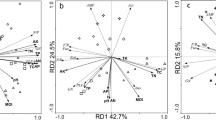Abstract
In agricultural ecosystems that have had consistent cropping histories, standard microbial methods may be used to evaluate past and present practices. Our objective was to evaluate several microbial methods that best indicate cropping histories and soil quality on long-term plots. We selected soil microbial carbon (C), phospholipid analyses, direct counts of total fungal and bacterial biomass, and soil enzymes (phosphatases) to measure direct and indirect microbial activity on the Sanborn Field and Tucker Prairie. The Sanborn Field has been under various cropping and management practices since 1888 and the Tucker Prairie is an uncultivated site. Seven different plots were chosen on the Sanborn Field and random samples were taken in the summit area on the Tucker Prairie, which represented a reference site. Soil microbial biomass C, phospholipids, and enzyme activity were reflective of the cropping and management histories observed on the Sanborn Field. Enzymatic activity was highly correlated to soil organic matter. The direct counts of fungal and bacterial biomass showed that fungal populations dominated these soils, which may be attributed to soil pH. Soil microbial biomass C and enzyme assays seemed to be better potential indicators of cropping histories than the other methods tested in the long-term plots.
Similar content being viewed by others
References
Anderson S, Gantzer CJ, Brown JR (1990) Soil physical properties after 100 years continuous cultivation. J Soil Water Conserv 45:117–121
Angers DA, Bissonnette N, Legere A, Samson N (1993) Microbial and biochemical changes induced by rotation and tillage in a soil under barley production. Can J Soil Sci 73:39–50
Babiuk LA, Paul EA (1970) The use of fluorescein isothiocyanate in the determination of the bacterial biomass of grassland soil. Can J Microbiol 16:57–62
Broder WM, Wagner GH (1988) Microbial colonization and decomposition of corn, wheat, and soybean residue. Soil Sci Soc Am J 52:112–117
Buyanovsky GA, Kucera CL, Wagner GH (1987) Comparative analyses of carbon dynamics in native and cultivated ecosystems. Ecology 68:2023–2031
Dick RP (1992) A review: Long-term effects of agricultural systems on soil biochemical and microbial parameters. Agricult Ecosys Environ 40:25–36
Dick RP, Gupta VVSR (1994) A conceptual model for the role of abiontic soil enzymes in microbial ecology: a potential analogue for soil quality. In: Pankhurst CE, Doube BM, Gupta VVSR, Grace PR (eds), Soil biota: Management in sustainable farming systems. Commonwealth Scientific and Industrial Research Organization (CSIRO), Australia, pp 167–168
Dick WA (1984) Influence of long-term tillage and crop rotation combinations on soil enzyme activities. Soil Sci Soc Am J 48:569–574
Doran JW (1980) Soil microbial and biochemical changes associated with reduced tillage. Soil Sci Soc Am J 44:765–771
Doran JW, Parkin TB (1994) Defining and assessing soil quality. In: Doran JW, Coleman DC, Bezdicek DF, Stewart BA (eds) Defining soil quality for a sustainable environment. Soil Science Society of America Special Publications 35, Madison, WI (in press) pp 3–21
Doran JW, Sarrantonio M, Janke R (1994) Strategies to promote soil quality and health. In: Pankhurst CE, Doube BM, Gupta VVSR, Grace PR (eds) Soil biota: management in sustainable farming systems. Commonwealth Scientific and Industrial Research Organization (CSIRO), Australia, pp 230–237
Findlay RH, King GM, Watling L (1989) Efficacy of phospholipid analysis in determining microbial biomass in sediments. Appl Environ Microbiol 55:2888–2893
Frankenberger WT, Dick WA (1983) Relationships between enzyme activities and microbial growth and activity indices in soil. Soil Sci Soc Am J 47:945–951
Ingham ER, Klein DA (1984) Soil fungi: Relationships between hyphal activity and staining with fluorescein diacetate. Soil Biol Biochem 16:273–278
Jordan D, Beare MH (1991) A comparison of methods for estimating soil microbial biomass C. Agric Ecosys Environ 34:35–41
Lodge DJ, Ingham ER (1991) A comparison of agar film techniques for estimating fungal biovolumes in litter and soil. Agric Ecosys Environ 34:131–144
Parkinson D, Coleman DC (1991) Microbial communities, activity, and biomass. Agric Ecosys Environ 34:3–33
SAS (Statistical Analysis System) (1988) SAS User Guide 6.03 Edition. SAS Institute, SAS Circle. Box 8000, Cary NC 27512-8000
Scrivner CL, Mcquigg JD, Brees dR (1972) Climatic areas and soil resources. Res in Agron Dept of Agronomy, Univ Missori-Columbia, Miscellaneous Publication 72–75:20–23
Tabatabai MA (1982) Soil enzymes: In: Page AL (ed) Methods of soil analysis, part 2. Chemical and microbiological properties. Agronomy 9, 2nd edn. Am Soc Agron, Madison, Wisconsin, pp 903–947
Veen van J, Paul EA (1979) Conversion of biovolume measurements of soil organisms, grown under various moisture tensions, to biomass and their nutrient content. Appl Environ Microbiol 37:686–692
Visser S, Parkinson D (1992) Soil biological criteria as indicators of soil quality: soil microorganisms. Am J Altern Agric 7:33–37
Voroney P, Paul EA (1984) Determination of Kc and Kn in situ for calibration of the chloroform fumigation-incubation method. Soil Biol Biochem 16:9–14
Author information
Authors and Affiliations
Additional information
This paper has been assigned by the Missouri Agricultural Experiment Station to Journal Series no. 12043
Rights and permissions
About this article
Cite this article
Jordan, D., Kremer, R.J., Bergfield, W.A. et al. Evaluation of microbial methods as potential indicators of soil quality in historical agricultural fields. Biol Fertil Soils 19, 297–302 (1995). https://doi.org/10.1007/BF00336098
Received:
Issue Date:
DOI: https://doi.org/10.1007/BF00336098




